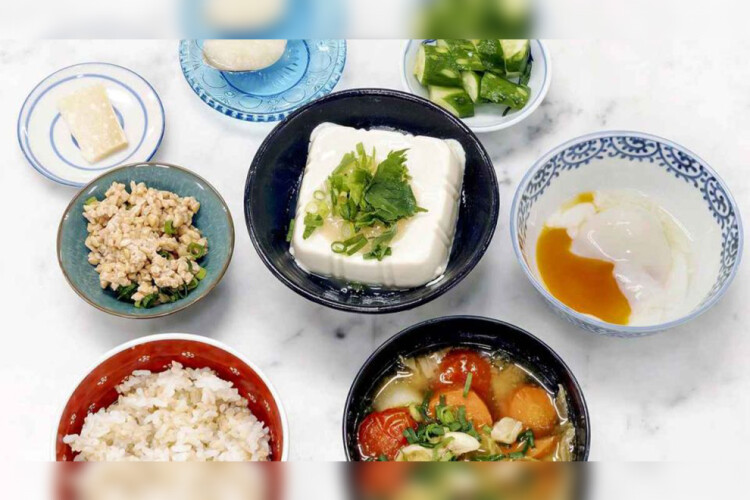
TOKYO – Cooking expert Sachiko Murakami, 83, who advocates the importance of meals for senior citizens living alone, has shared her ideas for maintaining a healthy diet even for those not good at cooking. As the population ages and the number of single-person households increases, it is said that many find cooking daunting because they feel it is too much effort or struggle to use all of the ingredients.
Even when she was still supporting her late husband, a company employee who was often transferred, and their three children, Murakami was helping people trying to cook for their families by suggesting quick and delicious recipes through newspapers, magazines and other media outlets.
However, due to the declining birthrate and aging population, as well as the increase in single-person households, more people are cooking for themselves. Murakami herself started living alone after her husband died in 2014.
Murakami said she often hears during her cooking classes from students of her same generation that they have become unable to eat as much as they used to or that cooking has become a hassle.
Considering these societal changes, in her recent books and other works she has been pushing the idea of “lowering barriers to cooking.”
“Our metabolisms keep renewing, so we need to keep eating. If you think cooking is a hassle, why not prioritize eating over spending time on food prep?” Murakami said recently at her kitchen studio in Fukuoka City.
Sachiko Murakami shows a “single-serving frozen food pack” in a container at her kitchen studio in Chuo Ward, Fukuoka. PHOTO: THE YOMIURI SHIMBUN
Murakami herself said she does not spend much time preparing her meals.
She showed me the studio’s back room, equipped with only a single-burner IH stove, a small refrigerator about one meter tall, a microwave and a round table. When eating alone, she often cooks and eats in the back room, she said.
Murakami then showed how she prepares her so-called repetitive breakfast.
In the freezer, she usually stores “single-serving frozen food” packs. Each pack is made with 100 grams of vegetables and 50 grams of a protein source like meat or fish, all cut into bite-sized pieces.
“Since the recommended daily intake of vegetables is 350 grams, you can almost achieve this by using one frozen pack per meal for breakfast, lunch and dinner, also ensuring you get plenty of protein,” Murakami said.
Murakami places one of the packs in a heat-resistant container, leaving the bag open, and heats it in the microwave at 600 watts for about 11/2 minutes.
Packs of single-serving frozen food contain 100 grams of vegetables and 50 grams of protein-rich foods each. PHOTO: THE YOMIURI SHIMBUN
Once the contents are slightly thawed, she transfers them into a container and fills it about 70%-80% with water. Then she adds one tablespoon of dashi-flavored liquid miso and mixes lightly. She then microwaves again, uncovered, for three minutes to finish off vegetable-packed “microwave miso soup.”
While heating 150 grams of freezer-stored rice in the microwave for about three minutes, she grabs items like natto, tofu, eggs, pickles or cheese from the refrigerator, placing them on small plates. A “sumptuous breakfast set meal” is ready in about 10 minutes.
“With eggs, natto or cheese, you can get lots of protein. Protein is essential for building the body, so be sure to get enough at breakfast,” she said.
The packs can be used in a variety of other dishes by adding to ramen or soup, or stir-frying, as examples.
Murakami freezes rice in 150-gram portions. She also prepares the single-serving frozen packs when she has time.
It’s Murakami’s philosophy to not hesitate to use what’s convenient. In addition to the liquid miso, Murakami cooks with deli foods sold at supermarkets and convenience stores.
One of her favorites is individually portioned oden. Oden is rich in protein because it has ingredients like fish cakes and eggs, but lacks vegetables. So, Murakami adds spinach.
To do so, she microwaves 100 grams of spinach for two minutes in a heat-resistant container, covered with plastic wrap. She then briefly dips in water and squeezes excess liquid out before adding to oden.
When using ready-made dishes, she advises to be careful to not take in too much salt. “Since they are made to taste delicious from the first bite, they tend to be high in salt,” she said. “You need to make some changes.”
To enjoy ready-made, simmered dishes like cooked hijiki seaweed or chikuzen-ni chicken and vegetables, Murakami microwaves them with a tablespoon of water for one minute, then discards the water the seasonings dissolved in.
For ready-made Chinese dishes like happosai — in which ingredients such as shrimp and vegetables are sauteed — and sweet and sour pork, Murakami adds chopped cabbage or onions and microwaves for about three minutes, making for a less salty dish filled with vegetables.
“Since making dishes like happosai, which requires many ingredients, can be time-consuming, it’s smart to make use of deli foods,” Murakami said.
“Today, more people can live to be almost 100 years old, but it is important to maintain a healthy, active body by having three proper meals a day,” she said.
Not everyone is able to cook due to health conditions and other circumstances. But Murakami said you can always go for ready-made dishes. “Try to have a balanced diet that includes all the nutrients your body needs.”
The chart of three food groups can also be used as reference to achieve a balanced diet.
GRAPHICS: THE YOMIURI SHIMBUN
Research by Yukako Tani, an assistant professor at the Institute of Science Tokyo, shows that elderly living alone with poor cooking skills are at higher risk of mortality.
Tani studied 10,647 elderly people who had not been assessed as requiring nursing care and who participated in the Japan Gerontological Evaluation Study, for about three years from 2016. Participants were divided into having high or poor cooking skills based on seven qualifiers, including “being able to peel vegetables or fruit” and “being able to cook simmered foods.” Over the course of this period, 520 of the participants died.
Using this data, people with the same conditions, such as whether they lived with others, age, sex, income and access to grocery stores, were compared based on differences in cooking skills.
Those with poor cooking skills who lived alone had a 2.5 times higher risk of death compared to those living alone with high cooking skills, it was concluded.
In cases where people lived with others, there was little difference in mortality rates regardless of cooking skills.
Those with poorer cooking skills also tended to cook less frequently, eat fewer vegetables and also tended to walk less.
“Being able to cook is likely to increase fruit and vegetable intake as well as the practice of physical activities such as shopping, ultimately leading to lower risk of death. I hope that from a young age people will be aware of the importance of cooking,” Tani said.
Asia News Network/The Japan News
Even when she was still supporting her late husband, a company employee who was often transferred, and their three children, Murakami was helping people trying to cook for their families by suggesting quick and delicious recipes through newspapers, magazines and other media outlets.
However, due to the declining birthrate and aging population, as well as the increase in single-person households, more people are cooking for themselves. Murakami herself started living alone after her husband died in 2014.
Murakami said she often hears during her cooking classes from students of her same generation that they have become unable to eat as much as they used to or that cooking has become a hassle.
Considering these societal changes, in her recent books and other works she has been pushing the idea of “lowering barriers to cooking.”
“Our metabolisms keep renewing, so we need to keep eating. If you think cooking is a hassle, why not prioritize eating over spending time on food prep?” Murakami said recently at her kitchen studio in Fukuoka City.
Sachiko Murakami shows a “single-serving frozen food pack” in a container at her kitchen studio in Chuo Ward, Fukuoka. PHOTO: THE YOMIURI SHIMBUN
Murakami herself said she does not spend much time preparing her meals.
She showed me the studio’s back room, equipped with only a single-burner IH stove, a small refrigerator about one meter tall, a microwave and a round table. When eating alone, she often cooks and eats in the back room, she said.
Murakami then showed how she prepares her so-called repetitive breakfast.
In the freezer, she usually stores “single-serving frozen food” packs. Each pack is made with 100 grams of vegetables and 50 grams of a protein source like meat or fish, all cut into bite-sized pieces.
“Since the recommended daily intake of vegetables is 350 grams, you can almost achieve this by using one frozen pack per meal for breakfast, lunch and dinner, also ensuring you get plenty of protein,” Murakami said.
Murakami places one of the packs in a heat-resistant container, leaving the bag open, and heats it in the microwave at 600 watts for about 11/2 minutes.
Packs of single-serving frozen food contain 100 grams of vegetables and 50 grams of protein-rich foods each. PHOTO: THE YOMIURI SHIMBUN
Once the contents are slightly thawed, she transfers them into a container and fills it about 70%-80% with water. Then she adds one tablespoon of dashi-flavored liquid miso and mixes lightly. She then microwaves again, uncovered, for three minutes to finish off vegetable-packed “microwave miso soup.”
While heating 150 grams of freezer-stored rice in the microwave for about three minutes, she grabs items like natto, tofu, eggs, pickles or cheese from the refrigerator, placing them on small plates. A “sumptuous breakfast set meal” is ready in about 10 minutes.
“With eggs, natto or cheese, you can get lots of protein. Protein is essential for building the body, so be sure to get enough at breakfast,” she said.
The packs can be used in a variety of other dishes by adding to ramen or soup, or stir-frying, as examples.
Murakami freezes rice in 150-gram portions. She also prepares the single-serving frozen packs when she has time.
It’s Murakami’s philosophy to not hesitate to use what’s convenient. In addition to the liquid miso, Murakami cooks with deli foods sold at supermarkets and convenience stores.
One of her favorites is individually portioned oden. Oden is rich in protein because it has ingredients like fish cakes and eggs, but lacks vegetables. So, Murakami adds spinach.
To do so, she microwaves 100 grams of spinach for two minutes in a heat-resistant container, covered with plastic wrap. She then briefly dips in water and squeezes excess liquid out before adding to oden.
When using ready-made dishes, she advises to be careful to not take in too much salt. “Since they are made to taste delicious from the first bite, they tend to be high in salt,” she said. “You need to make some changes.”
To enjoy ready-made, simmered dishes like cooked hijiki seaweed or chikuzen-ni chicken and vegetables, Murakami microwaves them with a tablespoon of water for one minute, then discards the water the seasonings dissolved in.
For ready-made Chinese dishes like happosai — in which ingredients such as shrimp and vegetables are sauteed — and sweet and sour pork, Murakami adds chopped cabbage or onions and microwaves for about three minutes, making for a less salty dish filled with vegetables.
“Since making dishes like happosai, which requires many ingredients, can be time-consuming, it’s smart to make use of deli foods,” Murakami said.
“Today, more people can live to be almost 100 years old, but it is important to maintain a healthy, active body by having three proper meals a day,” she said.
Not everyone is able to cook due to health conditions and other circumstances. But Murakami said you can always go for ready-made dishes. “Try to have a balanced diet that includes all the nutrients your body needs.”
The chart of three food groups can also be used as reference to achieve a balanced diet.
GRAPHICS: THE YOMIURI SHIMBUN
Research by Yukako Tani, an assistant professor at the Institute of Science Tokyo, shows that elderly living alone with poor cooking skills are at higher risk of mortality.
Tani studied 10,647 elderly people who had not been assessed as requiring nursing care and who participated in the Japan Gerontological Evaluation Study, for about three years from 2016. Participants were divided into having high or poor cooking skills based on seven qualifiers, including “being able to peel vegetables or fruit” and “being able to cook simmered foods.” Over the course of this period, 520 of the participants died.
Using this data, people with the same conditions, such as whether they lived with others, age, sex, income and access to grocery stores, were compared based on differences in cooking skills.
Those with poor cooking skills who lived alone had a 2.5 times higher risk of death compared to those living alone with high cooking skills, it was concluded.
In cases where people lived with others, there was little difference in mortality rates regardless of cooking skills.
Those with poorer cooking skills also tended to cook less frequently, eat fewer vegetables and also tended to walk less.
“Being able to cook is likely to increase fruit and vegetable intake as well as the practice of physical activities such as shopping, ultimately leading to lower risk of death. I hope that from a young age people will be aware of the importance of cooking,” Tani said.
Asia News Network/The Japan News










